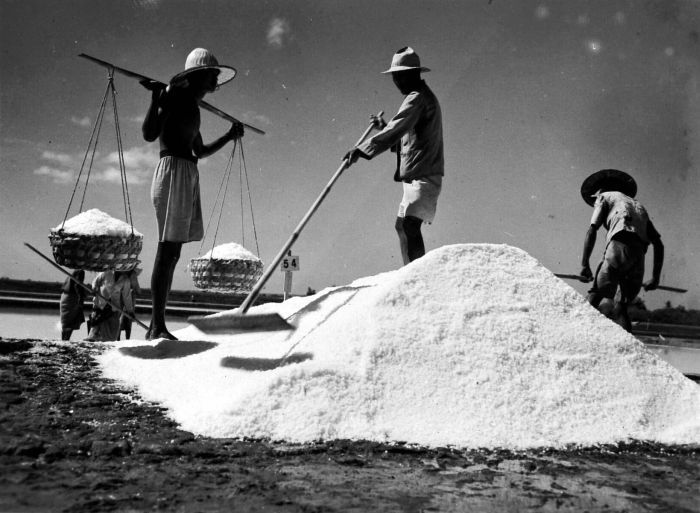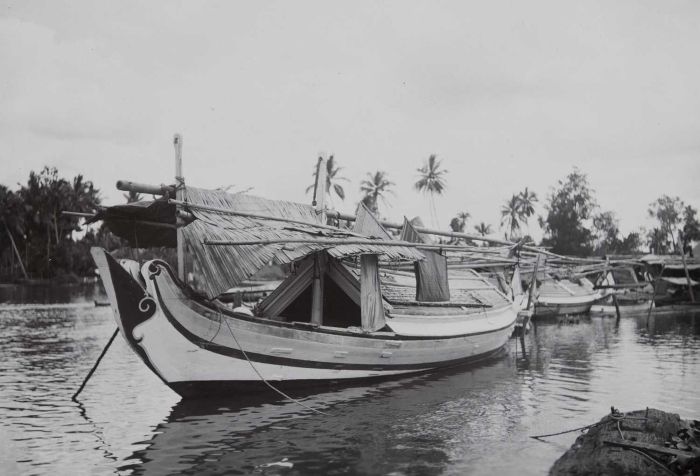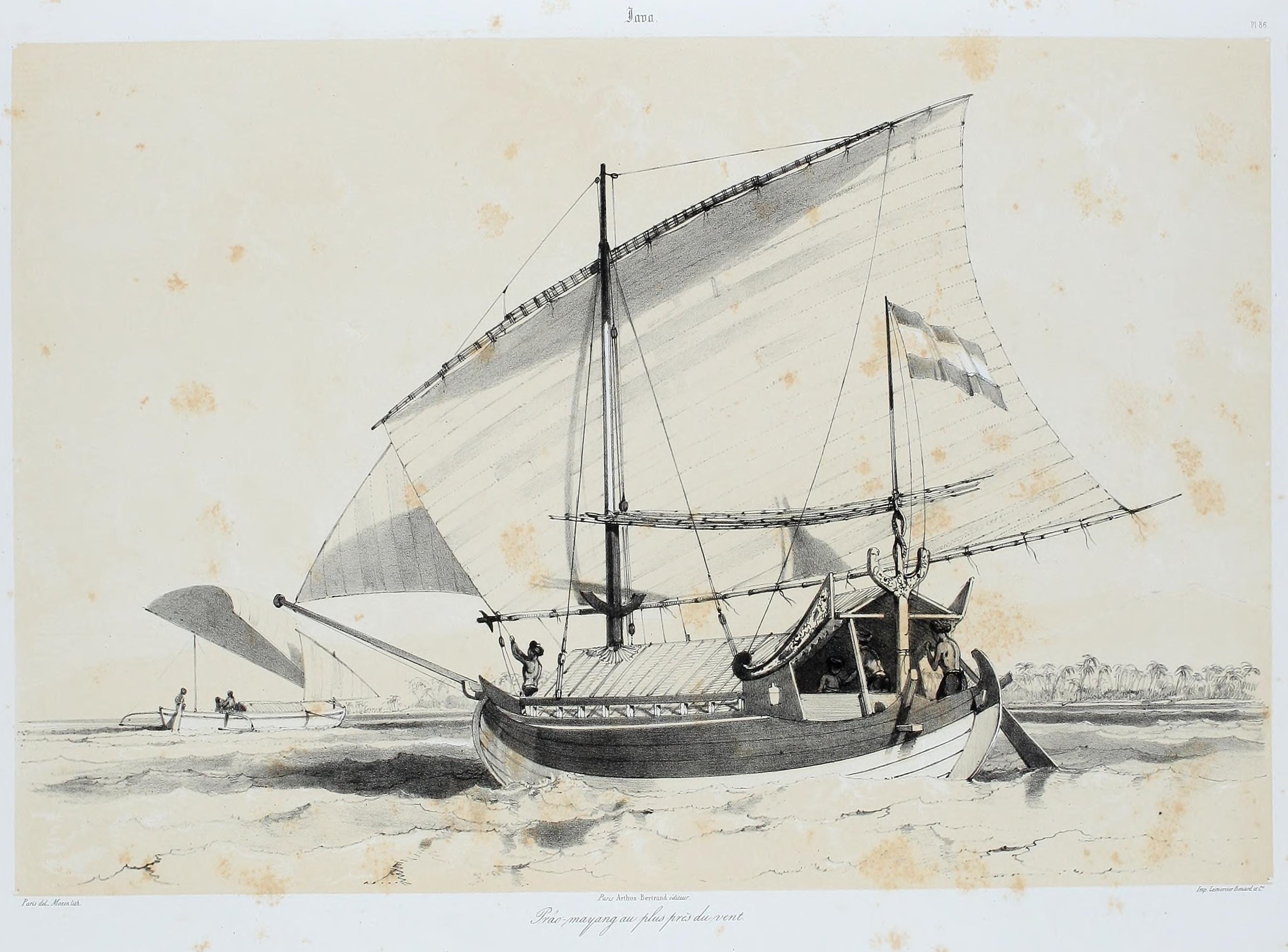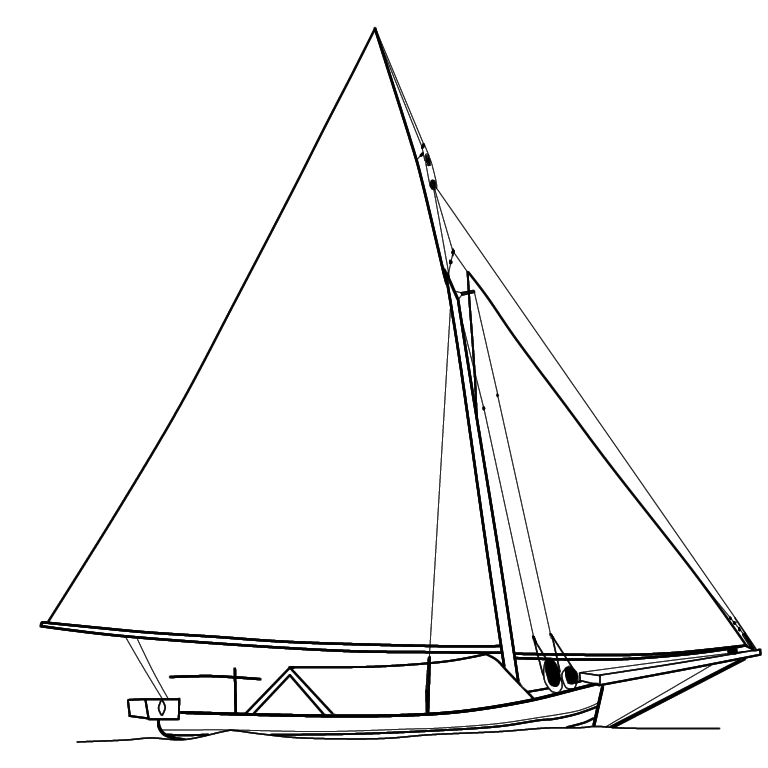|
Janggolan
Janggolan refers to two different type of ''perahu'' from Indonesia. One is from Madura, and the other from Bali. The Madurese janggolan is a type of indigenously constructed boat, meanwhile Balinese janggolan is an indigenous boat with western-styled hull construction. Madurese janggolan Janggolan in Madura comes from the western half of the south coast of Madura, from Kamal to Sampang. It is the largest from the family of boats with double stempost, like lis-alis. They can be found plying to Singapore in the past, being called "old-style golekkan". Etymology The word ''janggolan'' means transportation.Horridge (2015). p. 69. It is also called as ''parao janggol'' (meaning "transport perahu") by the Madurese. Like the alisalis, janggolan were regarded as "female" (''parao bini'' — female boat), and ornamental motif used were connected with the feminine.Stenross (2007). p. 277. Description Madurese janggolan can be identified by flat decorated face between the double ste ... [...More Info...] [...Related Items...] OR: [Wikipedia] [Google] [Baidu] |
Janggolan Bali Samping
Janggolan refers to two different type of ''perahu'' from Indonesia. One is from Madura, and the other from Bali. The Madurese janggolan is a type of indigenously constructed boat, meanwhile Balinese janggolan is an indigenous boat with western-styled hull construction. Madurese janggolan Janggolan in Madura comes from the western half of the south coast of Madura, from Kamal to Sampang. It is the largest from the family of boats with double stempost, like lis-alis. They can be found plying to Singapore in the past, being called "old-style golekkan". Etymology The word ''janggolan'' means transportation.Horridge (2015). p. 69. It is also called as ''parao janggol'' (meaning "transport perahu") by the Madurese. Like the alisalis, janggolan were regarded as "female" (''parao bini'' — female boat), and ornamental motif used were connected with the feminine.Stenross (2007). p. 277. Description Madurese janggolan can be identified by flat decorated face between the double stem ... [...More Info...] [...Related Items...] OR: [Wikipedia] [Google] [Baidu] |
Lis-alis
Lis-alis is a type of traditional boat of Madura, Indonesia. Lis-alis usually present in canals that provide salt evaporation service in southern part of Madura and around Surabaya. Until the present, lis-alis remained overwhelmingly popular as a fishing craft in Bangkalan and Sukolilo, while a larger version, the '' kroman'', has been used in this area for at least a century for inshore transport work. Etymology It is also known as alisalis or alis alis. The name come from Indonesian word ''alis'' which means "eyebrows". This may refer to an ornamental motif which does resemble a pair of eyebrows, often applied to the top of the bow. Eyebrows are an important aspect of feminine beauty in traditional Indonesian culture, and these boats strongly associated with the feminine — on the northwest coast they were commonly referred as ''parao bini'', which means "female boat". Description These boats come from varying size between 5 metres long to more than 10 metres. Usually the l ... [...More Info...] [...Related Items...] OR: [Wikipedia] [Google] [Baidu] |
Lis-alis
Lis-alis is a type of traditional boat of Madura, Indonesia. Lis-alis usually present in canals that provide salt evaporation service in southern part of Madura and around Surabaya. Until the present, lis-alis remained overwhelmingly popular as a fishing craft in Bangkalan and Sukolilo, while a larger version, the '' kroman'', has been used in this area for at least a century for inshore transport work. Etymology It is also known as alisalis or alis alis. The name come from Indonesian word ''alis'' which means "eyebrows". This may refer to an ornamental motif which does resemble a pair of eyebrows, often applied to the top of the bow. Eyebrows are an important aspect of feminine beauty in traditional Indonesian culture, and these boats strongly associated with the feminine — on the northwest coast they were commonly referred as ''parao bini'', which means "female boat". Description These boats come from varying size between 5 metres long to more than 10 metres. Usually the l ... [...More Info...] [...Related Items...] OR: [Wikipedia] [Google] [Baidu] |
Indonesian Inventions
This list of Indonesian inventions and discoveries details the indigenous arts and techniques, cultural inventions, scientific discoveries and contributions of the people of Indonesian archipelago — both ancient and modern state of Indonesia. As a developing nation, currently Indonesia suffers a shortage of scientific personnel and engineers. The lack of research and development, also hampers Indonesia's comparative competitiveness. Nevertheless, despite the shortcomings, its people and government continues their efforts to advance the nation's science and technology sectors. Among other things, by promoting innovation and technology through Indonesia Science Day. Since ancient times, native Indonesians has accumulated knowledge and developed technology stemmed from necessities; from naval navigation knowledge, traditional shipbuilding technology, textile techniques, food processing to vernacular house building. Notable examples include jong, pinisi, perahu, Borobudu ... [...More Info...] [...Related Items...] OR: [Wikipedia] [Google] [Baidu] |
Madura Island
Madura Island is an Indonesian island off the northeastern coast of Java. The island comprises an area of approximately (administratively 5,379.33 km2 including various smaller islands to the east, southeast and north that are administratively part of Madura's four regencies). Administratively, Madura is part of the province of East Java. It is separated from Java by the narrow Madura Strait. The administered area has a density of 744 people per km2 while main island has a somewhat higher figure of 826 per km2 in 2020. Etymology The name of Madura island is of Hindu origin. The origin of the island's name lies in the legend that the island is in the realm of Hindu deity Baladewa. The name ''Madura'' itself is derived from the word ''"Mathura"'' - a word in Indian-origin language Sanskrit for the native home of Baladewa "Baladeva". The corrupted form of Sanskrit word ''Mathura'' became the ''Madura''.Ed. Emma Helen Blair and James Alexander Robertson, 1903-09The Phili ... [...More Info...] [...Related Items...] OR: [Wikipedia] [Google] [Baidu] |
Golekan
Golekan is a type of traditional boat from Madura, Indonesia. They once plied as far as Singapore, where they are referred to as Madurese traders. In the present this type of boat is only known locally, especially near Bangkalan in Western Madura and around the Kangean islands.Horridge (2015). p. 79. Etymology Dutch observer van Deventer wrote that it means "freight seeker". Gibson-Hill stated the name comes from Malay word ''golek'', which he claimed meant crank (tender, or 'tippy') when applied to a canoe. Rather, the name derived from ''kolek'', a Javanese word for 'boat', applied to a wide range of small craft along the north coast of Java. Thus the name ''golekan'' would meant 'a kind of ''kolek'''.Stenross (2007). p. 275. Golekan in Madurese culture were regarded as "male", being referred to as ''parao laki'' (male boat), so it has different ornamental motif from lis-alis and janggolan (''parao bini'' — female boat). The primary symbol was the rooster, associated in Ind ... [...More Info...] [...Related Items...] OR: [Wikipedia] [Google] [Baidu] |
Leti Leti
Leti leti is a type of traditional transport vessel from East Madura, Indonesia, especially from the administrative district of Sumenep. The leti leti is a recent development, the hull form and sail were developed in the 19th century. In 1979 sailing leti leti was numbered about 1000, but this was reduced in the next decades when more modern, motorized vessel appeared.Horridge (2015). p. 82. Etymology Leti leti is also known with other names and pronunciation, like leti-leti, letelete, lete lete, letek-letek, leteh-leteh, parao lete', and golekan lete. The origin of the name is unknown. In early 20th century the type was referred to in different publications as ''tekletek''. This is however the same name, with the first syllable dropped: 'le'''tek-letek'', as in 'a'''lisalis''. It may also possible that the name comes from the sail it used, the Madurese crab claw sail, or lete sail, which has just developed in the 19th century. In fact, the "lete" from lete sail is a local pronu ... [...More Info...] [...Related Items...] OR: [Wikipedia] [Google] [Baidu] |
Leti Leti
Leti leti is a type of traditional transport vessel from East Madura, Indonesia, especially from the administrative district of Sumenep. The leti leti is a recent development, the hull form and sail were developed in the 19th century. In 1979 sailing leti leti was numbered about 1000, but this was reduced in the next decades when more modern, motorized vessel appeared.Horridge (2015). p. 82. Etymology Leti leti is also known with other names and pronunciation, like leti-leti, letelete, lete lete, letek-letek, leteh-leteh, parao lete', and golekan lete. The origin of the name is unknown. In early 20th century the type was referred to in different publications as ''tekletek''. This is however the same name, with the first syllable dropped: 'le'''tek-letek'', as in 'a'''lisalis''. It may also possible that the name comes from the sail it used, the Madurese crab claw sail, or lete sail, which has just developed in the 19th century. In fact, the "lete" from lete sail is a local pronu ... [...More Info...] [...Related Items...] OR: [Wikipedia] [Google] [Baidu] |
Sailboat Types
A sailboat or sailing boat is a boat propelled partly or entirely by sails and is smaller than a sailing ship. Distinctions in what constitutes a sailing boat and ship vary by region and maritime culture. Types Although sailboat terminology has varied across history, many terms have specific meanings in the context of modern yachting. A great number of sailboat-types may be distinguished by size, hull configuration, keel type, purpose, number and configuration of masts, and sail plan. Popular monohull designs include: Cutter The cutter is similar to a sloop with a single mast and mainsail, but generally carries the mast further aft to allow for a jib and staysail to be attached to the head stay and inner forestay, respectively. Once a common racing configuration, today it gives versatility to cruising boats, especially in allowing a small staysail to be flown from the inner stay in high winds. Catboat A catboat has a single mast mounted far forward and does not carr ... [...More Info...] [...Related Items...] OR: [Wikipedia] [Google] [Baidu] |
Pencalang
Pencalang is a traditional merchant ship from Nusantara. Historically it was called as pantchiallang or pantjalang. It was originally built by Malay people from the area of Riau and the Malay Peninsula, but has been copied by Javanese shipwrights.Liebner, Horst H. (2016). ''Beberapa Catatan Akan Sejarah Pembuatan Perahu Dan Pelayaran Nusantara''. Jakarta: Indonesian Ministry of Education and Culture. By the end of the 17th century this ship has been built by Javanese and Chinese shipbuilders in and around Rembang. However it was a popular choice for Balinese skippers followed by Sulawesian skippers. Etymology The word ''pencalang'' comes from Malay word, which has now been absorbed into Indonesian language, namely ''calang'' and ''mencalang'', which means "to scout", "to recon", and "to peek". Therefore, pencalang can be interpreted as "a boat used for spying" or "recon boat". According to VOC glossarium, the Malay word ''pentjalang'' means "ship that was sent on the lookout", ... [...More Info...] [...Related Items...] OR: [Wikipedia] [Google] [Baidu] |
Mayang (boat)
Perahu Mayang or simply mayang is a type of fishing boat from Java, Indonesia. This type of boat is used mainly for fishing and trading. Historically, this indigenous vessel is also favored by European skippers and private merchants for trading in East Indies: 50% of them were using mayang and pencalang. It is mostly used in northern coast of Java. The major production site is in Rembang, Central Java. Etymology The name mayang comes from ''payang'' (a type of seine) used by local fishermen. Thus the name can be translated as "using ''payang''". Description Major portion of the mayang hull is built using teak wood. The hull shape is broad, flat-bottomed with a pronounced bow and stern. It is deckless, but may have a covered "house" in the middle of the boat. Mayang are also built with a watertight bulkhead. In the 18th century, a Mayang is described as having a crew of 6 or 9 and is 12.2 to 15 metres long; with a 7.24 tonne burthen. A boat from 1850 had a beam of 3 m, a leng ... [...More Info...] [...Related Items...] OR: [Wikipedia] [Google] [Baidu] |
Lambo (boat)
The term lambo or lamba refer to two types of traditional boats from Indonesia. Butonese lambo Lambo is the Indonesian version of small western styled merchant boats with one mast from the end of the 19th century. It is directly developed as merchant boats, and unlike other boats from Indonesia, it was not derived from local fishing ''perahu'' or canoe.Horridge (2015). p. 125. Etymology The origin of the word "lambo" and its meaning is not clear. It is probable that this word is a crude dialog word meaning ''no mother", which means this boat doesn't incorporate ancestor traditions (that is, developed from Western boats). It may also be possible that, the word comes from Kawi (Old Javanese) language word "lambu" which means a kind of boat. Description It has two masts, with its sturdy rig and gaff easily recognized from afar. The defining features of this boat is the shape of the keel, bow, and the stern (it has "counter" type stern). Most of them weighed between 10 and ... [...More Info...] [...Related Items...] OR: [Wikipedia] [Google] [Baidu] |


_atau_Jabaran.png)








